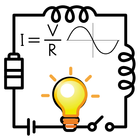Circuit Analysis Notes4


Rating

Genre
GAMES

Size
71.9 MB
Version
4
Update
Jun 22 2024
Circuit Analysis Notes APK for Android. Download now!
 Download
Download
Electrical Engineering App
Notes contains
Thevenin's Theorem
Mesh Analysis
Nodal Analysis
KCL
KVL
Superposition Theorem
Norton's Theorem
etc.
What's New in the Latest Version 4
Last updated on Jun 22, 2024
Minor bug fixes and improvements. Install or update to the newest version to check it out!
Circuit Analysis Notes: A Comprehensive Summary
Circuit analysis forms the bedrock of electrical engineering, providing the tools and techniques to understand and predict the behavior of electrical circuits. From simple resistive networks to complex systems involving active components, circuit analysis allows engineers to design, optimize, and troubleshoot electronic devices and systems. This comprehensive summary explores the fundamental concepts and methodologies employed in circuit analysis.
1. Basic Circuit Elements:
Resistors, capacitors, and inductors are the fundamental passive elements encountered in circuits. Resistors impede current flow, capacitors store energy in an electric field, and inductors store energy in a magnetic field. Each element is characterized by its specific constitutive relationship: Ohm's law for resistors (V=IR), the capacitor equation (I=C(dV/dt)), and the inductor equation (V=L(dI/dt)). Understanding these relationships is crucial for analyzing circuit behavior.
2. Kirchhoff's Laws:
Kirchhoff's Current Law (KCL) and Kirchhoff's Voltage Law (KVL) are fundamental principles governing circuit behavior. KCL states that the algebraic sum of currents entering a node is zero, reflecting the principle of charge conservation. KVL states that the algebraic sum of voltages around any closed loop in a circuit is zero, reflecting the principle of energy conservation. These laws provide powerful tools for analyzing circuit networks.
3. Circuit Analysis Techniques:
Several techniques facilitate circuit analysis. Node-voltage analysis assigns voltages to each node in the circuit and applies KCL to formulate a system of equations. Mesh-current analysis assigns currents to each mesh (loop) in the circuit and applies KVL to formulate equations. Superposition, applicable to linear circuits, analyzes the circuit's response to each independent source individually and then sums the individual responses to obtain the total response. Thevenin's and Norton's theorems simplify complex circuits by representing them as equivalent circuits consisting of a single voltage or current source and a single impedance.
4. AC Circuit Analysis:
AC circuits involve sinusoidal voltages and currents. Phasor representation simplifies analysis by representing sinusoidal quantities as complex numbers. Impedance, the AC equivalent of resistance, incorporates resistance, capacitance, and inductance. AC circuit analysis utilizes the same fundamental laws as DC analysis, but with phasor representation and impedance calculations. Concepts like power factor, apparent power, and reactive power become relevant in AC circuits.
5. Transient Analysis:
Transient analysis examines the circuit's response to sudden changes, such as switching events. Differential equations describe the circuit's behavior during the transient period. Techniques like Laplace transforms provide powerful tools for solving these equations and determining the circuit's response over time. Concepts like time constants and steady-state response are crucial in transient analysis.
6. Frequency Response:
Frequency response analysis examines the circuit's behavior as a function of frequency. Transfer functions, expressed as ratios of output to input phasors, characterize the circuit's response to different frequencies. Bode plots graphically represent the magnitude and phase of the transfer function versus frequency, providing insights into the circuit's frequency characteristics. Concepts like bandwidth, resonance, and filtering are essential in frequency response analysis.
7. Operational Amplifiers (Op-Amps):
Op-amps are versatile active components with high gain and input impedance. They are widely used in various circuit applications, including amplification, filtering, and signal processing. Ideal op-amp analysis simplifies calculations by assuming infinite gain and input impedance. Practical op-amp considerations involve finite gain, input bias currents, and offset voltages.
8. Digital Circuits:
Digital circuits operate with discrete voltage levels, typically representing binary values (0 and 1). Logic gates are the fundamental building blocks of digital circuits, implementing logical operations like AND, OR, and NOT. Boolean algebra provides a mathematical framework for analyzing and designing digital circuits. Combinational logic circuits implement logical functions based on the current input values, while sequential logic circuits incorporate memory elements to store previous states.
This comprehensive summary provides a broad overview of the key concepts and techniques in circuit analysis. Mastering these principles is essential for any electrical engineer seeking to design, analyze, and troubleshoot complex electronic systems.
4 / 5 ( 225 votes )









